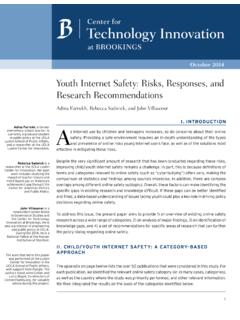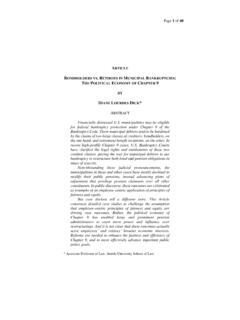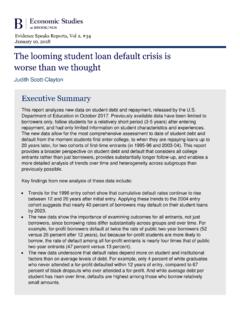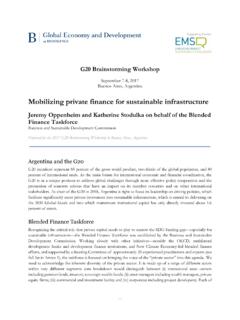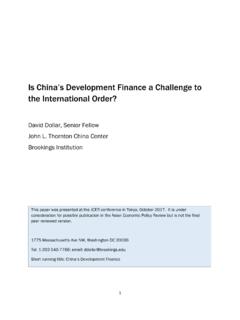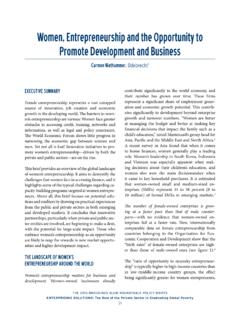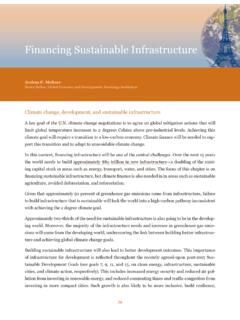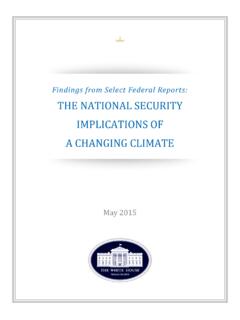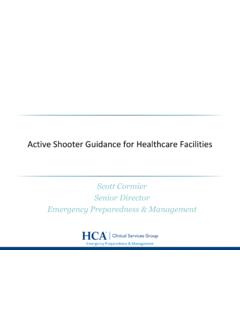Transcription of CARIBBEAN REGIONAL DISASTER RESPONSE AND …
1 CARIBBEAN . REGIONAL DISASTER . RESPONSE . AND MANAGEMENT. MECHANISMS: PROSPECTS AND. CHALLENGES. Brookings-LSE Project on Internal Displacement July 2013. BROOKINGS. CARIBBEAN REGIONAL DISASTER RESPONSE and Management Mechanisms: Prospects and Challenges By Mark Kirton July 2013. PUBLISHED BY: THE BROOKINGS-LONDON SCHOOL OF ECONOMICS. PROJECT ON INTERNAL DISPLACEMENT. Mark Kirton, PhD. University of the West Indies St. Augustine, Trinidad and Tobago This report was made possible thanks to generous support from the Australian Civil-Military Centre. Front Cover Photograph: A man working through a temporary employment program funded by USAID. through CHF moves rubble near the sea in, Carrefour, Haiti, February 15, 2011 (courtesy of Kendra Helmer/USAID). Back Cover Photographs: Left: This building served as a temporary shelter for those who had to evacuate their homes during hurricane sandy , Dominican Republic, November 1, 2012 (courtesy of EU - EC/ECHO/Gloria Do ate). Right: Through a series of workshops, the Rainforest Alliance education team has provided Maya Biosphere Reserve-based teachers with the resources they need to bring an understanding and appreciation of the surrounding environment into their classrooms, Guatemala, March 26, 2009 (courtesy of Charlie Watson USAID/Rainforest Alliance Forestry Enterprises).
2 Table of Contents Approaches to REGIONAL DISASTER Management in the Comprehensive DISASTER The Role of National DISASTER The Important Role of International REGIONAL DISASTER Management Mechanisms in the CARIBBEAN : Roles, Challenges and Acronyms ACS Association of CARIBBEAN States ACP Africa CARIBBEAN Pacific CADM CARIBBEAN DISASTER Management CARICOM CARIBBEAN Community CARDIN CARIBBEAN DISASTER Information Network CCA Climate Change Adaptation CCCCC CARIBBEAN Community Climate Change Centre CCRIF CARIBBEAN Catastrophe Risk Insurance Facility CDB CARIBBEAN Development Bank CDEMA CARIBBEAN DISASTER and Emergency Management Agency CDERA CARIBBEAN DISASTER Emergency RESPONSE Agency CDM Comprehensive DISASTER Management CDM-CHC Comprehensive DISASTER Management Coordination and Harmonization Council CDMP CARIBBEAN DISASTER Mitigation Project CDRMP CARIBBEAN DISASTER Risk Management Program CELP CARIBBEAN Emergency Legislation Project CHAMP CARIBBEAN Hazard Mitigation Capacity Building Programme CIDA Canadian International Development Agency CIMH CARIBBEAN Institute of Meteorology and Hydrology DEM Department of Emergency Management DRM DISASTER Risk Management DRR DISASTER Risk Reduction EOC
3 Emergency Operations Center EU European Union ENSO El Ni o Southern Oscillation FAO Food and Agricultural Organization GDP Gross Domestic Product IDB Inter-American Development Bank i IFRC International Federation of the Red Cross and Red Crescent Societies JICA Japan International Cooperation Agency LSAR Land Based Search and Rescue NDC National DISASTER Coordinator NDO National DISASTER Office NGO Non-Governmental Organization NOAA National Oceanic and Atmospheric Administration OAS Organization of American States ODIPERC Office of DISASTER Preparedness and Emergency Relief Coordination ODPM Office of DISASTER Preparedness and Management OFDA United States Office of Foreign DISASTER Assistance PAHO Pan American Health Organization RCC REGIONAL Climate Center RRM REGIONAL RESPONSE Mechanism SIDS Small Island Developing States SRCC Sub- REGIONAL Coordinating Center SRFP Sub- REGIONAL Focal Points TC Tropical Cyclone TEMA Tobago Emergency Management Agency UNDAC United Nations DISASTER Assessment and Coordination UNDP United Nations Development Programme UN/ISDR United Nations secretariat of the International Strategy for DISASTER Risk Reduction UN/OCHA United Nations Office for Coordination of Humanitarian Affairs USAID United States Agency for International Development WTTC World Tourism and Travel Council ii Introduction The increasing intensity and frequency with which disasters are being experienced worldwide demonstrate the critical need to enhance DISASTER risk management.
4 Indeed, high-profile, large- scale disasters are increasing global consciousness of the need to strengthen national and REGIONAL capacities to mitigate, respond to and manage such events (Ferris and Petz 2013). Small Island Developing States (SIDS) of the CARIBBEAN are particularly vulnerable for a number of reasons and face a range of disasters, both natural and man-made (UNDP 2011). As the United Nations Development Programme (UNDP) has recognized, CARIBBEAN countries are vulnerable to a range of hazards1 due to, and often exacerbated by, their ..geology, tectonic setting, location and topography, as well as their ..poor land use and environmental management practices (UNDP 2011:1). Disasters in the CARIBBEAN often cause millions of dollars in losses to infrastructure and to economic and social sectors of countries in the region. For example, 2004 was one of the busiest and most destructive Atlantic hurricane seasons on record: direct losses and property damage in the CARIBBEAN were estimated at $2 billion (UNDP 2011).
5 In Haiti, a devastating earthquake struck the island in 2010, killing more than 300,000 people. According to Dominique Zephyr, the human impact of the earthquake was immense and far greater than other recent earthquakes of similar magnitude, primarily because it occurred in a large urban area with many poorly- constructed buildings (Zephyr 2011). The Inter-American Development Bank (IDB) (Cavallo et al. 2010) estimated that the cost of the earthquake was between $ and $ billion. Also occurring in 2010, hurricane Tomas caused significant damage to several CARIBBEAN islands. According to the National Oceanic and Atmospheric Administration Tropical Cyclone Report on hurricane Tomas, there were 44 casualties and damage in St. Lucia amounted to $ million, $ million in Barbados and $ million in St. Vincent and the Grenadines (NOAA hurricane Tomas Report 2011). In August 2012, hurricane Isaac moved through the region, resulting in 12 deaths in Haiti. hurricane sandy , which passed through the CARIBBEAN region in November 2012 before moving to the eastern coast of the United States, impacted several countries, causing nearly 80 deaths, including 54 in Haiti.
6 More than million Haitians were affected by the hurricane , which also damaged critical infrastructure in the region including houses, hospitals, schools and roads (UN News Service 2012). hurricane sandy also caused significant damage to the agricultural sector in some CARIBBEAN states and the United States Agency for International Development (USAID) reported that in Haiti, [p]ost-storm assessments indicated that the hurricane destroyed more than 90,000 hectares of crops, compounding harvest losses sustained during Tropical Storm Isaac in August 2012 and drought conditions earlier in the year (USAID 2013:1). Flooding is one of the most frequently occurring natural disasters in the CARIBBEAN . In several states, flooding is most prevalent during the hurricane season and presents a serious threat to the socio-economic development of the region. In Guyana in 2005 for example, floods resulted in $55 million in damage to the agricultural sector and the following year caused approximately $ million in damages, negatively impacting the country's development (CARDI 2012).
7 1. The UNDP notes that these hazards include tropical cyclones, floods, seismic and volcanic activities, droughts, and bush fires, among others. 1. Additionally, in 2010, flooding resulting from Tropical Storm Nicole caused damage to infrastructure in Jamaica, St. Lucia, Barbados, Antigua, St. Vincent, and Belize among other countries in the region (Nation-News 2010). As the Association of CARIBBEAN States (ACS). Report, Strengthening Hydro-meteorological Operations and Services in The CARIBBEAN SIDS. notes, flooding either due to flash floods associated with tropical cyclones or due to periods of prolonged rainfall, has been the most common and frequent hydro-meteorological hazard that has affected the environment and the socio-economic development of many CARIBBEAN islands in a major way (ACS Report :7). This has added to the need for more coordinated DISASTER management systems in the region. Droughts have also negatively affected the economic and social sectors of several CARIBBEAN states and, as the ACS Report ( ) indicated, droughts are often related to the El Ni o Southern Oscillation (ENSO).
8 Some countries in the region, such as Guyana (which had serious droughts in 1997), regularly experience an abnormal lack of rainfall, especially during the dry season. Droughts lead to losses in the agricultural sector as well as increasing human suffering among the region's inhabitants. It has also been noted that the geology and climate of the CARIBBEAN contribute to the prevalence of landslides in the region. Contemporary research indicates that weather patterns, de-forestation and increasing population density are among the major causes of landslides in the region. Recent landslides in August 2012 claimed the lives of two people in Trinidad and Tobago (Gonzales 2012). Landslides in December 2012 and April 2013 caused extensive damage to roads and homes (Williams 2012; Williams 2013). Landslides are generally recorded as DISASTER events and the World Bank estimates that 40 percent of global economic losses due to landslides are experienced in the CARIBBEAN and Central and in South America (Dilley et al.)
9 2005). These examples indicate the increasing frequency and range of natural disasters which, coupled with the intensified levels of vulnerability in the CARIBBEAN , demonstrates the need for sustained REGIONAL efforts to confront the challenges brought on by climatic and environmental hazards in the region. Not only are they susceptible to natural disasters, but CARIBBEAN SIDS possess a number of inherent characteristics which both exacerbate their fragility and constrain their ability to respond to catastrophic events (Ramsaran and Hosein 2008). Notably, they are heavily dependent on the tourism and agricultural industries, both of which are adversely impacted by weather conditions. This dependence results in a high level of economic vulnerability. With respect to tourism, the total contribution of travel and tourism to the 2012 Gross Domestic Product (GDP) of the CARIBBEAN was 14 percent, the highest for any region in the world (WTTC 2013). In the case of CARIBBEAN destinations, tourism's contribution to GDP in 2012 ranged from percent in the British Virgin Islands, to percent in Anguilla and 22 percent in the Bahamas an indication of the important role of the sector in the region's economies (See Appendix, Table 1).
10 An ECLAC study posits that: [G]iven the region's high dependence on tourism, the passage of any natural event typically implies high public costs to replace public structures as well as 2. visitor facilities. Moreover, the accompanying disruption of travel and communications services also result in high economic losses as tourism businesses may be suspended for extensive periods while the country effects needed repairs and restoration of service (Phillips 2011: 14). Given that the CARIBBEAN coastal zones are at the heart of the tourism industry, the tourism sector is immensely vulnerable to natural disasters. One ACS Report stated: This is especially true for the tourism sector where beaches and related built development such as hotels, marinas, and water sports constitute a major share of the sub-region's tourism infrastructure, and are therefore subject to significant damage and loss from natural events. For instance, it is estimated that of approximately 420 places of accommodation on the island of Barbados in 2007, 90% were sited on the coastline (ECLAC 2007: 29).
